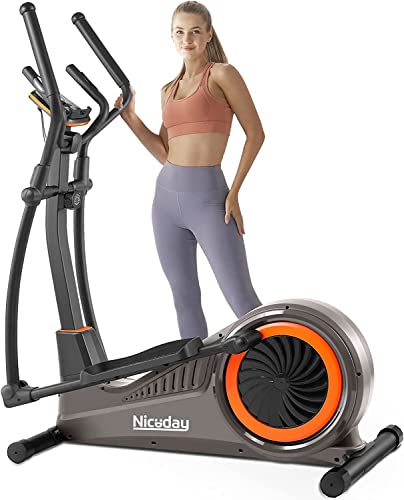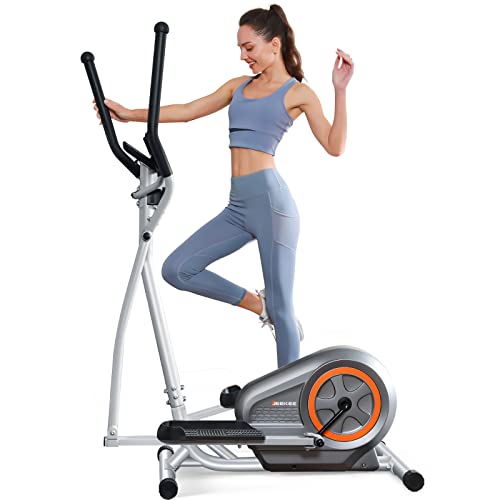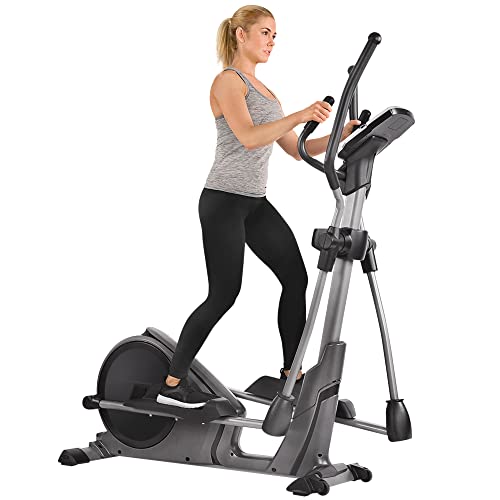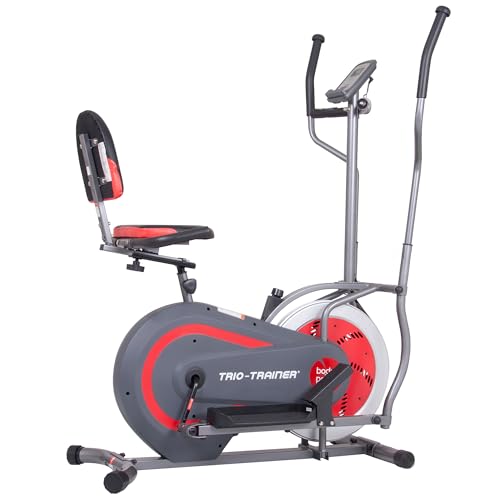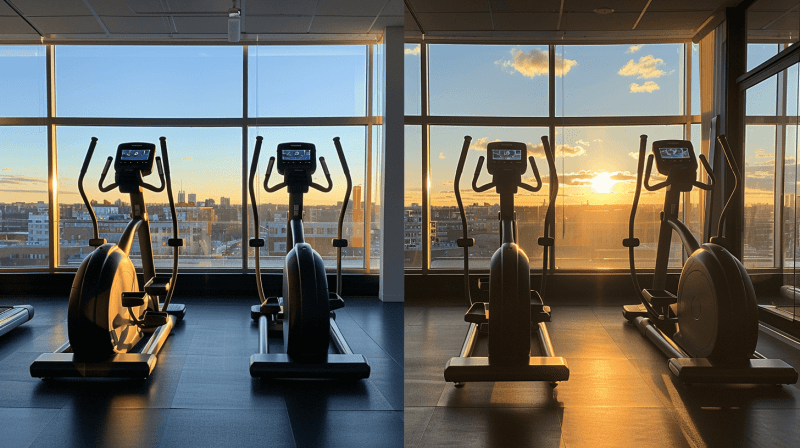When you step onto an elliptical machine at your local gym, you'll notice the resistance dial offering levels from 1 to 20, leading you to wonder if cranking it up might help build muscle like traditional weights do. While you're moving against resistance and engaging multiple muscle groups, there's an important distinction between elliptical workouts and true strength training that can impact your fitness goals. Understanding this difference won't just help you make better workout choices - it'll determine whether you're actually building strength or simply improving your endurance. Let's explore what really happens to your muscles during elliptical exercise and how it compares to conventional strength training.
Key Takeaways
-
Elliptical machines provide mild resistance training but cannot match the muscle-building potential of traditional weight training exercises.
-
While ellipticals engage multiple muscle groups, they primarily focus on cardiovascular fitness rather than significant strength development.
-
The resistance levels on ellipticals are insufficient to create enough mechanical tension for substantial muscle growth.
-
Elliptical workouts build muscular endurance but lack the progressive overload necessary for significant strength gains.
-
For effective strength training, elliptical exercises should be supplemented with dedicated resistance training using weights or resistance bands.
Understanding Resistance Training Fundamentals
Most strength or resistance training fundamentally relies on progressive overload - the gradual increase of stress placed on your muscles and bones. When you engage in traditional resistance training, you'll challenge specific muscle groups with weights, bands, or bodyweight exercises that create microscopic damage to muscle fibers, which then repair and grow stronger during recovery periods.
To effectively build muscle through strength training, you'll need to consistently increase the demands on your muscles beyond their current capabilities. Weight training typically involves using free weights, machines, or resistance bands with specific rep ranges and sets designed to target different fitness goals, from muscle endurance to maximum strength gains.
The key principle behind exercises that build strength is mechanical tension - the force your muscles must generate to overcome resistance. You'll find that proper strength training programs incorporate compound movements that work multiple muscle groups simultaneously, as well as isolation exercises for specific muscle development. When designing your resistance training routine, you should focus on progressive increases in weight, repetitions, or time under tension to continue seeing improvements in strength and muscle mass. Incorporating low impact exercises into your routine can help protect joints while still providing adequate stimulus for muscular strength and growth.
Elliptical Machine Mechanics
An elliptical machine operates through a low-impact, continuous circular motion that mimics the natural movement of walking or running. When you're using the machine, you'll engage multiple muscle groups simultaneously while supporting your body weight through the pedals and handles.
The elliptical machine's resistance system works through electromagnetic or mechanical means, allowing you to adjust the difficulty of your workout. As you increase the resistance, your muscles need to work harder to maintain the same motion, though this isn't equivalent to traditional strength training with progressive overload.
Key features of elliptical machine mechanics include:
- Dual-action handles that engage your upper body muscles while your legs push and pull
- Adjustable stride length that targets different muscle groups and accommodates various user heights
- Variable incline settings that shift emphasis between different lower body muscles
- Flywheel system that certifies smooth, consistent motion throughout your workout
The machine's design distributes your body weight across multiple contact points, reducing impact on your joints while still allowing for cardiovascular training and some muscle engagement. While you'll experience muscle activation during your workout, the resistance isn't typically high enough to stimulate significant strength gains.
The oval-like cyclic motion helps users maintain proper body alignment while strengthening the back of the leg muscles.
Muscle Groups During Elliptical Exercise
Working out on an elliptical machine activates a thorough range of muscle groups throughout your body. During elliptical training, your legs receive the primary focus, with your quadriceps, hamstrings, and glutes working together to power the pedaling motion. When you maintain proper form, you'll engage these lower body muscles in a fluid, controlled movement that helps build muscular endurance.
Your upper body isn't left out of this full-body workout, as the moving handles engage your chest, shoulders, and arm muscles. While these muscles work, your core muscles, including your abdominals and lower back, constantly activate to keep you stable and balanced throughout the exercise. This simultaneous engagement of multiple muscle groups makes the elliptical an efficient choice for thorough training.
You can intensify how hard these muscles work by adjusting the resistance level on your machine. Higher resistance settings will challenge your muscles more drastically, while maintaining proper form promises you're getting the most out of your workout. The combination of lower body, upper body, and core engagement truly makes elliptical training a complete exercise experience. The neuromuscular control benefits of elliptical training can help reduce injury risks while building strength and stability.
Resistance Levels and Muscle Development
The resistance settings on your elliptical machine play a major role in determining how effectively you'll build muscle strength and endurance. When you increase the resistance levels, you're transforming your cardiovascular workout into a legitimate form of resistance training that engages multiple muscle groups simultaneously.
To maximize muscle development on the elliptical, you'll want to focus on:
- Gradually increasing resistance levels to achieve progressive overload
- Maintaining proper form while pushing and pulling the handles for upper body engagement
- Alternating between high and low resistance intervals to challenge different muscle groups
- Using higher resistance settings during specific portions of your workout to target muscle strength
While lower resistance settings primarily benefit cardiovascular health, higher resistance levels create the necessary stimulus for muscle development. Your body responds to this increased demand by adapting and building both muscle strength and muscle endurance over time. The combination of the pushing and pulling motions with increased resistance effectively works your legs, hips, core, and upper body muscles, making the elliptical a viable option for incorporating resistance training into your fitness routine. This full-body workout approach provides a low-impact alternative to traditional strength training while still effectively engaging major muscle groups.
Comparing Traditional Strength Training
Traditional strength training fundamentally differs from elliptical workouts in both approach and results. When you're lifting weights or performing bodyweight exercises, you're directly challenging your muscles with specific loads that can be progressively increased over time. This targeted resistance allows you to effectively build both upper body and lower body strength through controlled movements and deliberate muscle engagement.
While the elliptical provides some resistance through its pushing and pulling motions, it can't match the muscle-building potential of dedicated strength training exercises. You'll notice that the resistance on an elliptical primarily supports cardiovascular fitness and muscular endurance, rather than maximal strength development. The machine's continuous, fluid motion doesn't create the same level of muscular overload that you'd get from traditional weight training methods.
To achieve thorough fitness results, you'll want to combine your elliptical workouts with traditional strength training exercises. This balanced approach guarantees you're developing both cardiovascular fitness and muscular strength effectively. Remember that while the elliptical can help tone muscles, it shouldn't be your sole method for building strength and muscle mass. The low-impact nature of elliptical training makes it an ideal complement to more intense strength workouts while protecting your joints from excessive stress.
Weight Bearing Benefits
Understanding weight-bearing benefits requires distinguishing between high-impact and low-impact exercises. While using an elliptical machine does provide some weight-bearing advantages for your body, it's considered a low-impact activity that offers limited bone-strengthening benefits compared to other exercises.
When you're looking to build bone density through weight-bearing activities, consider these key differences:
- Your feet never fully leave the elliptical pedals, which reduces the impact necessary to stimulate significant bone growth
- Upper body movements on the elliptical don't create enough resistance to build substantial bone density
- High-impact exercises like running and jumping provide more effective bone loading
- The downward force generated while using an elliptical is considerably less than traditional weight-bearing exercises
While the elliptical can be an excellent choice for cardiovascular fitness and joint-friendly workouts, it shouldn't be your primary exercise if bone strength is your main goal. The machine's design intentionally minimizes impact, which makes it less effective for building bone density compared to activities where your feet regularly leave the ground, such as running or jumping rope. To maximize muscle engagement during your elliptical workout, focus on driving through heels while maintaining proper form with relaxed shoulders and an engaged core.
Progressive Overload on Elliptical
Progressive overload on an elliptical machine centers around systematically increasing the challenge to your muscles through various adjustable settings. As you work both your upper and lower body on the elliptical trainer, you'll need to continually adjust resistance levels to guarantee you're providing adequate stimulus for muscular adaptation and growth.
You can implement progressive overload through multiple variables on your elliptical machine. By increasing the resistance settings, you'll force your muscles to work harder during each session, while adjusting the incline or stride length creates additional challenges that target different muscle groups. This approach to endurance training helps you burn calories more effectively while building muscular strength.
To maximize your results, consider incorporating interval training into your aerobic exercise routine. You'll want to alternate between periods of higher and lower resistance, which can stimulate muscle development more effectively than maintaining a steady pace. As your fitness improves, gradually increase your workout duration and frequency while maintaining proper form. For complete strength gains, combine your elliptical training with traditional resistance exercises, creating an all-encompassing fitness program that addresses both cardiovascular and muscular development.
Building Muscular Endurance
While progressive overload focuses on increasing resistance over time, muscular endurance training on the elliptical machine takes a different approach. Using an elliptical regularly with moderate to high resistance can greatly improve muscular endurance, allowing your muscles to work longer before becoming fatigued.
To maximize your muscular endurance gains while using an elliptical, consider these key strategies:
- Maintain consistent workouts between 20-60 minutes to challenge your muscular stamina
- Adjust the resistance level throughout your session to target different muscle groups
- Incorporate high-intensity intervals with increased resistance to build endurance faster
- Combine elliptical training with strength exercises to create a comprehensive fitness plan
When you're working toward your workout goal of enhanced muscular endurance, elliptical machines provide an effective platform for training. The key is to let different training methods work together, as the combination of steady-state cardio and resistance-based exercises creates ideal conditions for endurance development. By adjusting variables like duration, resistance, and intensity, you can create a customized program that steadily builds your muscular endurance while maintaining joint-friendly movement patterns.
Proper Form for Maximum Results
Proper form on the elliptical machine can make the difference between a mediocre workout and one that delivers maximum strength and cardiovascular benefits. To build muscle and maintain an ideal heart rate during your training session, you'll need to focus on positioning your body correctly from head to toe.
Start by standing tall with your core muscles engaged and your feet positioned shoulder-width apart. You'll want to press through your heels while maintaining an upright posture, which helps activate different muscles in your legs more effectively during your elliptical exercise.
Keep your elbows close to your body while gripping the handles, using them to drive the movement and engage your upper body muscles.
Remember that proper form isn't just about positioning—it's also about movement quality. Maintain a controlled, steady pace rather than rushing through your workout, as this will improve your muscle engagement and joint stability. You can enhance your results by adjusting the resistance and incline levels throughout your session, which helps target various muscle groups and keeps your body challenged in new ways.
Combining Elliptical With Strength Workouts
An effective fitness routine often integrates both cardio and strength training elements, and the elliptical machine can serve as a valuable bridge between these two workout styles. When you're looking to build muscle as quickly as possible while maintaining cardiovascular health and fitness, combining elliptical workouts with traditional strength exercises creates a powerful synergy.
To optimize your results, consider incorporating these strategic combinations:
- Alternate between high-resistance elliptical intervals that assist the quads and other lower body exercises to target two muscles groups effectively
- Perform strength training first, then use the elliptical build phase as a metabolic finisher
- Structure your week with dedicated strength days and elliptical workout sessions for recovery
- Combine 15-minute elliptical segments with bodyweight exercises for circuit-style training
The key to successful integration lies in proper periodization of your workouts. By thoughtfully planning when and how you'll combine elliptical sessions with strength training, you'll create an inclusive routine that enhances both muscular development and cardiovascular fitness. This balanced approach guarantees you're working toward multiple fitness goals simultaneously while allowing adequate recovery between intense sessions.
Frequently Asked Questions
Is Elliptical Considered Strength Training?
No, elliptical isn't primarily strength training. While you'll engage leg muscles, it's mainly cardio. You'll burn calories and work primary muscle groups with low joint stress, but won't build significant strength like traditional resistance training.
Is 30 Minutes a Day on Elliptical Enough?
You might think 30 minutes isn't much, but it's perfect for cardiovascular fitness improvement and calorie burn rate goals. However, you'll need additional strength training if you're aiming for serious muscle toning effects.
Can You Get in Shape Just Using an Elliptical?
You'll see cardio endurance improvement and some weight loss using just an elliptical, but you'll need to add strength training for complete fitness. It's great for cardiovascular health but won't build significant muscle alone.
Is Using an Elliptical Considered Weight-Bearing Exercise?
Yes, you'll get weight-bearing benefits on an elliptical, but at a lower intensity than running. While it's a low-impact exercise that reduces joint stress, you'll still engage muscles and enjoy cardiovascular benefits.
Conclusion
While your elliptical workouts are like stepping stones on your fitness journey, they don't fully replace traditional strength training. You'll gain cardiovascular benefits and muscular endurance, but you won't achieve maximum strength gains through elliptical exercise alone. For best results, you should combine your elliptical sessions with dedicated resistance training to create a well-rounded fitness program that builds both endurance and strength effectively.

